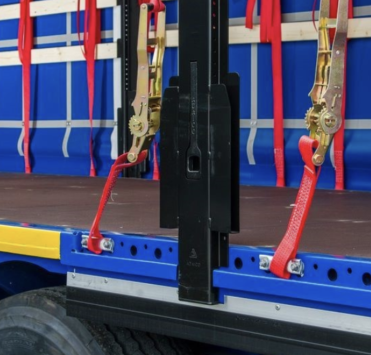Refrigerated containers in international transportation: how to deliver goods to Ukraine

Transportation of refrigerated containers (refcontainers) is one of the key areas in the field of container transportation when it comes to perishable and temperature sensitive goods. In this article we will consider how refrigerated containers are organized, for what goods they are necessary, as well as what factors should be taken into account when shipping them to Ukraine.
In addition, you will find practical recommendations for optimizing the logistics process, learn about the basic requirements for the transportation of temperature goods and get answers to frequently asked questions.
What are refrigerated containers and how do they work?
Refrigerated containers (or Reefer Containers) are hermetically sealed containers with built-in refrigeration equipment that allows to maintain a specified temperature and humidity throughout the entire journey. The principle of operation is based on the following components:
- Compressor and condenser system: cools or heats the space inside the container, maintaining the desired temperature range.
- Insulation: insulated walls, doors and floor help minimize heat exchange with the outside environment.
- Ventilation system: allows controlling humidity levels and gas exchange, which is especially important for certain types of fruits and vegetables.
Thanks to these technological features, refcontainers provide reliable protection for goods that require strict temperature control.
What goods require refcontainers
Transportation of temperature cargo in refrigerated containers is relevant for a wide range of products. Refrigerated containers are most often used for:
- Food products
- Frozen meat, fish, seafood
- Fresh vegetables, fruits, berries
- Dairy products (milk, yogurt, cheese)
- Frozen semi-finished and ready meals
- Pharmaceutical and medical goods
- Vaccines requiring strict temperature conditions
- Medications sensitive to temperature fluctuations
- Biological materials (blood, sera, test kits)
- Chemicals
- Special reagents and chemical compounds
- Materials that lose their properties if temperature conditions are not met
- Cosmetic goods
- Creams, lotions and other products subject to deterioration under improper storage conditions.
In all cases, improper temperature conditions may cause damage to cargo, change its structure or reduce its consumer value.
Features of temperature cargo transportation to Ukraine
When planning the delivery of refrigerated containers to Ukraine, it is important to take into account a number of local regulations and peculiarities of the logistics process.
Compliance with the temperature regime
- Optimal temperature range: For each type of cargo a precise temperature corridor should be defined and maintained in advance (e.g. -20...-25 °C for frozen products, +2...+8 °C for fresh vegetables/fruits, etc.).
- Continuous monitoring: Modern refrigerated containers are equipped with temperature monitoring and recording systems. While en route, logistics operators monitor the parameters and respond promptly in case of deviations from the norm.
Customs and veterinary and sanitary formalities
- Phytosanitary and veterinary requirements: When importing food products, inspections are carried out, so it is important to have the necessary certificates (quality, origin, etc.).
- Documentation: Invoices, packing lists, veterinary and phytosanitary certificates are required to pass customs and sanitary control. Errors in documentation can lead to delays at the border or fines.
Organization of container transportation of refrigerated cargoes
Proper organization of container transportation using refrigerated containers is a guarantee of cargo safety and optimal delivery time.
Control at all stages of transportation
- Online monitoring: Many operators use remote temperature control systems to monitor the temperature inside the refrigerated container, receiving notifications when it does not meet the established parameters.
- Warehouse terminals and transshipment points: If the route is multimodal (sea + rail or road), transit warehouses and terminals should also have facilities to connect the refrigerated container to the power grid.
Packing and securing the cargo
- Uniform air circulation: Products are placed with gaps between the walls of the container and the goods so as not to block the circulation of cold air.
- Protection from mechanical damage: The use of shock-absorbing packaging and proper stowage of the cargo will help to avoid deformation during transportation.
Important aspects when shipping to Ukraine
- Port Infrastructure: In Ukraine, the most important role is played by seaports of Odessa, Chernomorsk. Choose a port with well-developed infrastructure and the possibility of uninterrupted power supply to refrigerated containers.
- Customs clearance: Estimated time is sometimes increased due to queues at checkpoints and internal checks. Plan ahead and work with customs brokers who are familiar with perishable goods requirements.
- Seasonal factors: The Ukrainian climate is characterized by distinct seasons, so in summer there may be a significant increase in energy costs for cooling, and in winter - to maintain a plus temperature.
Advantages of refrigerated containers
- Flexibility and versatility
- Suitable for transportation of a wide variety of goods - from frozen fish to medicines requiring +2...+8 °C.
- Safe and secure
- Temperature control and ventilation systems protect goods from spoilage and loss of quality.
- Minimize handling
- In containerized transport, goods are loaded once and unloaded at the final destination, reducing the risk of damage.
- Wide choice of logistics routes
- Refrigerated containers can be transported by sea, rail or road.
- Economies of scale
- For large delivery volumes, a refrigerated container is often more economical than using individual small isothermal vans or thermo boxes.
Common mistakes when shipping refrigerated containers
- Improper preparation of the container
- Refrigeration system, temperature sensors and airtightness were not checked before loading.
- Lack of sanitization
- Neglecting to sanitize the container can lead to cargo contamination and rapid bacterial growth.
- Container overloading
- Overfilling interferes with cold air circulation and causes localized overheating zones.
- No insurance for equipment failure
- Refrigeration system failure or power failures can result in cargo damage and substantial losses.
- Incomplete or incorrect documents
- Errors in customs declarations, missing quality certificates or veterinary certificates delay goods at the border.
Recommendations
- Choose reliable partners: Logistics operators with extensive experience in refrigerated transportation and continuous temperature monitoring can help reduce the risk of cargo spoilage.
- Conduct continuous monitoring: Modern technology allows you to monitor temperatures remotely and respond to problems in real time.
- Consider seasonality and infrastructure: Plan routes according to climate conditions, port capacity and the availability of the necessary equipment to handle refrigerated containers.
- Comply with documentary formalities: Customs, veterinary and phytosanitary requirements in Ukraine are often strict, so prepare all paperwork well in advance.
Transportation of refrigerated containers to Ukraine is a logically structured and complex process in which the main goal is to preserve the quality of goods at optimal time. Compliance with all of the above recommendations will ensure successful delivery and protect the cargo from critical temperature deviations.
FAQ - Frequently Asked Questions
1. What is the optimal temperature for transportation of frozen seafood?
Typically, the temperature is maintained between -20 and -25 °C, but specific values depend on the type of product and the manufacturer's recommendations.
2. How long can a refrigerated container operate without power?
The autonomous operation time depends on the model of refrigeration unit and external conditions. On average - from several hours to a day. However, for long transportation, connection to the power grid is mandatory.
3. Is it possible to transport different types of goods in one refrigerated container?
Theoretically, it is possible if the temperature and humidity requirements are the same. However, mixed loading may increase the risk of spoilage under different storage conditions for each group of goods.
4. What documents are required to import pharmaceutical products in a refrigerated container?
Certificates of conformity, certificates of state registration (if necessary), commercial invoices, packing lists and other documents confirming the origin and quality of drugs should be provided.









